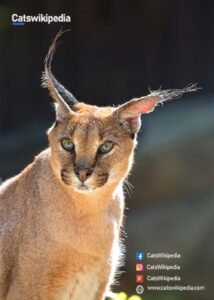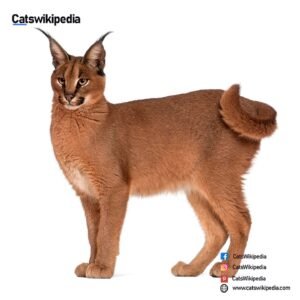Caracal Cats
Introduction to Caracal Cats
The medium-sized wild cat, commonly known as the Caracal (Caracal), is known for agility and beautiful color. So many ranges of them have been recorded. The Felidae family holds this short-tailed cat; it can be seen in so many places including the plains and hills, along with deserts. Its origin is in parts of Asia, the Middle East, and Africa. Due to versatility in various habitats and with spectacular hunting ability, the Caracal cats have become one of the most interesting members of the wild cat family. Although they are abundant, problems and issues with regards to conservation will definitely appear since the Caracal is threatened in some places.

Physical Features
The black-tufted ears and reddish-brown coat are typical characteristics of the sleek, short-haired caracal cats. These ear tufts range between 1.75 inches in length and become one of the greatest features of the Caracal. The underparts of the cat are normally lighter, usually whitish, and the coat is typically tawny-brown to reddish-tan. This coloring can blend the Caracal cats with their natural environment while chasing after prey, making them have great concealment in their natural habitat.
The caracal cat is a tall animal with long legs, measuring at the shoulder to 40–45 cm (16–18 inches). Its body length ranges between 66 and 76 cm, except for its tail which is short; it measures between 20 and 25 cm (7.9–9.8 inches) long. This is why Caracal has streamlined body appearance as a result of its short tail and long legs, suited for a fast-moving predatory habit.
Habitat and Distribution
This illustrates that caracals are flexible animals in various ecological circumstances and thrive in all areas of diverse environments, from the Middle East, Asian central and southwest, and African plains, highlands, and deserts. Caracals can thrive in any of these environments in Africa-from the savannas, the dry Sahara deserts, up to even wooded surroundings. Their extraordinary resilience is demonstrated in adapting and living in areas with a deficiency of prey and water.
Caracals are generally found in the dry and desert areas of the Middle East. They can live in such harsh environments, but they continue to exist there by killing many birds, reptiles, and small mammals. Such caracals also live in regions with more forest cover in this region where they may acquire shelter and hunting opportunities provided by denser vegetative cover.
Central Asia is another type of habitat for caracals, as it might make them hold grasslands, rocky terrain, and desert regions. The dramatic adaptation and survival character of the Caracal are presented by its ability to hunt and move over a very diverse range of terrain.

Behavior and Diet
The main activity of the Caracal is hunting, often nocturnal and solitary. A lethal predator, this agile and swift cat preys on many animals, including reptiles, birds, and mammals. Some of the prey that the Caracal feeds on are gazelles, hares, rats, and peafowl, among others.
This is one of the most fantastic hunting techniques of the Caracal : it leaps to a height of 4 meters (about 13 feet) in order to catch birds in mid-air. This is a great feat of the animal’s strength and agility.
Claimed to be proud, and the fastest cats on land, the Caracal speed at 50 miles per hour, or 80 kilometers per hour. With absolute speed, agility, and quick jumping features, this cat can do any feat for any hunter, airborne and land-based.
For centuries, caracal cats are being trained in Asia and served as training for hunting animals. They are of invaluable use as partners in hunting, especially in the places with small game as the main source of prey. Their keen hunting instincts and trainability make them incredibly valuable.
Life and Breeding
The mating habits of the caracals are almost similar with all the other wild cats. Vaginal deliveries, normally, occur in litters of one to four children following almost three months of gestation. The young caracals are almost similar in appearance to the adult in terms of color and have the well-characterized ear tufts that the adults have. The mother gives the babies care and teaches them the necessary things to survive until they are able to fend for themselves.
The Caracal cats have a lifespan of 12 years in the wild where it faces the challenges of predators and other natural impeding factors. However, caracals live much longer in captivity. They are provided with regular food, medical care, and harm-free safety. They live for up to 16 years or more. This difference shows how their environment is a determining factor in the longevity of such an animal.
State of Conservation
Although considered a “Least Concern” animal by the International Union for Conservation of Nature (IUCN), caracals caracals are greatly differing regionally. While it is generally assumed that caracals have a stable global population, threats or endangerment is reported in North Africa, Turkey, parts of Central Asia, and India, among others. The main causes of the decline of caracal cats population in these regions are habitat loss through degradation, poaching, as well as human-wildlife conflict.
North African regions have also paid a price since the development of human and agricultural growth. The most serious threats occur in Turkey and central Asia, as the animals are hunted for their skin or as revenge against the caracal cat killing livestock. The key factors causing the decline of caracal cats in India are Habitat loss and Human encroachment.

Final words about Caracal cats
The Caracal, indeed, is a rare, robust wild cat with a rather unique look, agility, and adaptability. This sleek predator can be found in diverse habitats across Africa, the Middle East, and Central Asia and adapts to survive in some of the planet’s most hostile conditions. Its strong legs, eye-catching black-tufted ears, and long jumps make it perhaps one of the most prolific hunters in the wild.
The caracal cats have been described as a species of least concern across the globe, although in many sites, they are threatened or endangered and thus pose serious challenges for them. The sustainability of caracal populations in these regions is dependent on conservation efforts that shield them from habitat degradation, poaching, and human-wildlife conflict. We may be able to save this marvellous animal in the future by learning about the potential dangers that it may face and its special adaptations.



